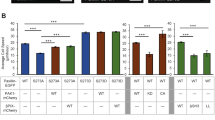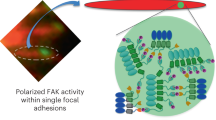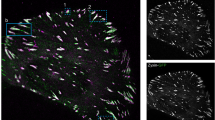Abstract
Focal adhesion turnover is a complex process required for cell migration. We have previously shown that the Ste20-like kinase (SLK) is required for cell migration and efficient focal adhesion (FA) turnover in a FA kinase (FAK)-dependent manner. However, the role of SLK in this process remains unclear. Using a candidate substrate approach, we show that SLK phosphorylates the adhesion adapter protein paxillin on serine 250. Serine 250 phosphorylation is required for paxillin redistribution and cell motility. Mutation of paxillin serine 250 prevents its phosphorylation by SLK in vitro and results in impaired migration in vivo as evidenced by an accumulation of phospho-FAK-Tyr397 and altered FA turnover rates. Together, our data suggest that SLK phosphorylation of paxillin on serine 250 is required for FAK-dependent FA dynamics.
This is a preview of subscription content, access via your institution
Access options
Subscribe to this journal
Receive 50 print issues and online access
$259.00 per year
only $5.18 per issue
Buy this article
- Purchase on Springer Link
- Instant access to full article PDF
Prices may be subject to local taxes which are calculated during checkout








Similar content being viewed by others
Accession codes
References
Horwitz AR, Parsons JT . Cell migration—movin’ on [comment]. Science 1999; 286: 1102–1103.
Abou Z N, Valles AM, Boyer B . Serine phosphorylation regulates paxillin turnover during cell migration. Cell Commun Signal 2006; 4: 8.
Bellis SL, Perrotta JA, Curtis MS, Turner CE . Adhesion of fibroblasts to fibronectin stimulates both serine and tyrosine phosphorylation of paxillin. Biochem J 1997; 325 (Pt 2): 375–381.
Hoellerer MK, Noble ME, Labesse G, Campbell ID, Werner JM, Arold ST . Molecular recognition of paxillin LD motifs by the focal adhesion targeting domain. Structure 2003; 11: 1207–1217.
Webb DJ, Donais K, Whitmore LA, Thomas SM, Turner CE, Parsons JT et al. FAK-Src signalling through paxillin, ERK and MLCK regulates adhesion disassembly. Nat Cell Biol 2004; 6: 154–161.
Manes S, Mira E, Gomez-Mouton C, Lacalle RA, Martinez C . Cells on the move: a dialogue between polarization and motility. IUBMB Life 2000; 49: 89–96.
Zaidel-Bar R, Ballestrem C, Kam Z, Geiger B . Early molecular events in the assembly of matrix adhesions at the leading edge of migrating cells. J Cell Sci 2003; 116 (Pt 22): 4605–4613.
Ezratty EJ, Partridge MA, Gundersen GG . Microtubule-induced focal adhesion disassembly is mediated by dynamin and focal adhesion kinase. Nat Cell Biol 2005; 7: 581–590.
Gilcrease MZ . Integrin signaling in epithelial cells. Cancer Lett 2007; 247: 1–25.
Romer LH, Birukov KG, Garcia JG . Focal adhesions: paradigm for a signaling nexus. Circ Res 2006; 98: 606–616.
Broussard JA, Webb DJ, Kaverina I . Asymmetric focal adhesion disassembly in motile cells. Curr Opin Cell Biol 2008; 20: 85–90.
Efimov A, Schiefermeier N, Grigoriev I, Brown MC, Turner CE, Small JV et al. Paxillin-dependent stimulation of microtubule catastrophes at focal adhesion sites. J Cell Sci 2008; 121 (Pt 2): 196–204.
Efimov A, Kaverina I . Significance of microtubule catastrophes at focal adhesion sites. Cell Adh Migr 2009; 3: 285–287.
Kaverina I, Krylyshkina O, Small JV . Microtubule targeting of substrate contacts promotes their relaxation and dissociation. J Cell Biol 1999; 146: 1033–1044.
O'Reilly PG, Wagner S, Franks DJ, Cailliau K, Browaeys E, Dissous C et al. The Ste20-like kinase SLK is required for cell cycle progression through G2. J Biol Chem 2005; 280: 42383–42390.
Wagner S, Storbeck CJ, Roovers K, Chaar ZY, Kolodziej P, McKay M et al. FAK/src-family dependent activation of the Ste20-like kinase SLK is required for microtubule-dependent focal adhesion turnover and cell migration. PLoS ONE 2008; 3: e1868.
Wagner S, Flood TA, O'Reilly P, Hume K, Sabourin LA . Association of the Ste20-like kinase (SLK) with the microtubule. Role in Rac1-mediated regulation of actin dynamics during cell adhesion and spreading. J Biol Chem 2002; 277: 37685–37692.
Roovers K, Wagner S, Storbeck CJ, O’Reilly P, Lo V, Northey JJ et al. The Ste20-like kinase SLK is required for ErbB2-driven breast cancer cell motility. Oncogene 2009; 28: 2839–2848.
Brown MC, Turner CE . Paxillin: adapting to change. Physiol Rev 2004; 84: 1315–1339.
Brown MC, Turner CE . Roles for the tubulin- and PTP-PEST-binding paxillin LIM domains in cell adhesion and motility. Int J Biochem Cell Biol 2002; 34: 855–863.
Webb DJ, Schroeder MJ, Brame CJ, Whitmore L, Shabanowitz J, Hunt DF et al. Paxillin phosphorylation sites mapped by mass spectrometry. J Cell Sci 2005; 118 (Pt 21): 4925–4929.
Etienne-Manneville S, Hall A . Integrin-mediated activation of Cdc42 controls cell polarity in migrating astrocytes through PKCzeta. Cell 2001; 106: 489–498.
Hagel M, George EL, Kim A, Tamimi R, Opitz SL, Turner CE et al. The adaptor protein paxillin is essential for normal development in the mouse and is a critical transducer of fibronectin signaling. Mol Cell Biol 2002; 22: 901–915.
Webb DJ, Brown CM, Horwitz AF . Illuminating adhesion complexes in migrating cells: moving toward a bright future. Curr Opin Cell Biol 2003; 15: 614–620.
Scheswohl DM, Harrell JR, Rajfur Z, Gao G, Campbell SL, Schaller MD . Multiple paxillin binding sites regulate FAK function. J Mol Signal 2008; 3: 1.
Deramaudt TB, Dujardin D, Hamadi A, Noulet F, Kolli K, De Mey J et al. FAK phosphorylation at Tyr-925 regulates cross-talk between focal adhesion turnover and cell protrusion. Mol Biol Cell 2011; 22: 964–975.
Zimerman B, Volberg T, Geiger B . Early molecular events in the assembly of the focal adhesion-stress fiber complex during fibroblast spreading. Cell Motil Cytoskeleton 2004; 58: 143–159.
Petit V, Boyer B, Lentz D, Turner CE, Thiery JP, Valles AM . Phosphorylation of tyrosine residues 31 and 118 on paxillin regulates cell migration through an association with CRK in NBT-II cells. J Cell Biol 2000; 148: 957–970.
Nayal A, Webb DJ, Brown CM, Schaefer EM, Vicente-Manzanares M, Horwitz AR . Paxillin phosphorylation at Ser273 localizes a GIT1-PIX-PAK complex and regulates adhesion and protrusion dynamics. J Cell Biol 2006; 173: 587–589.
Wu HY, Liao PC . Analysis of protein phosphorylation using mass spectrometry. Chang Gung Med J 2008; 31: 217–227.
Delom F, Chevet E . Phosphoprotein analysis: from proteins to proteomes. Proteome Sci 2006; 4: 15.
Loyet KM, Stults JT, Arnott D . Mass spectrometric contributions to the practice of phosphorylation site mapping through 2003: a literature review. Mol Cell Proteomics 2005; 4: 235–245.
Canas B, Lopez-Ferrer D, Ramos-Fernandez A, Camafeita E, Calvo E . Mass spectrometry technologies for proteomics. Brief Funct Genomic Proteomic 2006; 4: 295–320.
Huang C, Rajfur Z, Borchers C, Schaller MD, Jacobson K . JNK phosphorylates paxillin and regulates cell migration. Nature 2003; 424: 219–223.
Duclos B, Marcandier S, Cozzone AJ . Chemical properties and separation of phosphoamino acids by thin-layer chromatography and/or electrophoresis. Methods Enzymol 1991; 201: 10–21.
Storbeck CJ, Wagner S, O'Reilly P, McKay M, Parks R, Westphal H et al. The Ldb1 and Ldb2 Transcriptional co-factors interact with the Ste20-like kinase SLK and regulate cell migration. Mol Biol Cell 2009; 20: 4174–4182.
Acknowledgements
This work was supported by the Canadian Institute for Health Research and the Canadian Breast Cancer Foundation. JLQ, KB and KNA-Z are the recipient of a Canadian Breast Cancer Foundation scholar award. LAS is the recipient of a CIHR scholar award. PO is the recipient of an OGSST studentship.
Author information
Authors and Affiliations
Corresponding author
Ethics declarations
Competing interests
The authors declare no conflict of interest.
Additional information
Supplementary Information accompanies the paper on the Oncogene website
Rights and permissions
About this article
Cite this article
Quizi, J., Baron, K., Al-Zahrani, K. et al. SLK-mediated phosphorylation of paxillin is required for focal adhesion turnover and cell migration. Oncogene 32, 4656–4663 (2013). https://doi.org/10.1038/onc.2012.488
Received:
Revised:
Accepted:
Published:
Issue Date:
DOI: https://doi.org/10.1038/onc.2012.488
Keywords
This article is cited by
-
AKT-mediated phosphorylation of Sox9 induces Sox10 transcription in a murine model of HER2-positive breast cancer
Breast Cancer Research (2021)
-
Deletion of the Ste20-like kinase SLK in skeletal muscle results in a progressive myopathy and muscle weakness
Skeletal Muscle (2017)
-
Phosphotyrosine profiling of curcumin-induced signaling
Clinical Proteomics (2016)
-
SATB2 enhances migration and invasion in osteosarcoma by regulating genes involved in cytoskeletal organization
Oncogene (2015)
-
Decipher the dynamic coordination between enzymatic activity and structural modulation at focal adhesions in living cells
Scientific Reports (2014)



